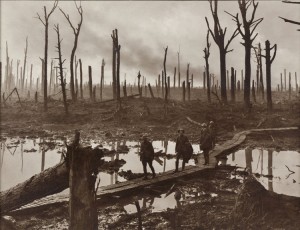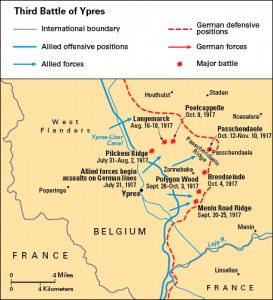Third Battle of Ypres 100
Tuesday, August 1st, 2017August 1, 2017
Yesterday, July 31, marked the 100th anniversary of the start of the Third Battle of Ypres, a bloody fight mainly conducted by British and Commonwealth troops against German forces during World War I (1914-1918). As the name implies, the battle—often simply called “Third Ypres” or “Passchendaele” after a village at the center of the fight—was the third battle of the war fought in and around the Belgian city of Ypres <<EE pruh>> (also spelled Ieper <<EE puhr>>). Many thousands of people died in the first two battles, but it was the Third Battle of Ypres that became notorious for its misery and great slaughter. The battle began on July 31, 1917, and lasted more than three months.

Australian soldiers follow a duckboard track through the shattered and flooded battlefield near Passchendaele, Belgium, during the Third Battle of Ypres on Oct. 29, 1917. Credit: Frank Hurley, Australian War Memorial
Two nights ago, on Sunday, July 30, ceremonies of remembrance took place at Ypres’ market square and at the Menin Gate Memorial to the Missing. Menin Gate lists the names of more than 54,000 British and Commonwealth soldiers who died in and around Ypres during World War I but have no known graves. The horrific nature of the fighting around Ypres accounted for an unusually high number of missing soldiers. On Monday, the British and Belgian royal families attended ceremonies at Tyne Cot Cemetery—where many of the unidentified British and Commonwealth dead are buried in graves marked simply, “A Soldier of the Great War.” Other events in the Ypres area opened new memorials and exhibitions and honored family members of the fallen, while still other ceremonies in other places remembered the dead of other nations.

Click to view larger image
The Third Battle of Ypres began 100 years ago this week on July 31, 1917. After three months of fighting, the Allies advanced less than 6 miles (10 kilomters). Credit: WORLD BOOK map
The first two battles of Ypres took place in 1914 and 1915. By the summer of 1917, fighting in the area had destroyed the landscape as well as the city of Ypres itself. The third battle began with a British bombardment and assault on German positions on July 31. German resistance was tough, and downpours of rain turned the shattered battlefield into a mucky swamp. Thousands of men on both sides died as the armies fought continuously for small scraps of barren, muddy ground. Fighting continued under horrible conditions for more than three months, during which time the British advanced less than 6 miles (10 kilometers). The battle ended in a British “victory” with the taking of Passchendaele ridge on November 6. About 250,000 British soldiers were killed, wounded, or captured at Third Ypres, while German casualties also surpassed 200,000. The troops who fought and died at Ypres came from Australia, Belgium, Canada, France, Germany, India, Ireland, New Zealand, South Africa, and the United Kingdom.
To this day, the village name Passchendaele (pronounced in English like Passion-dale or Passion-dell) evokes the accumulative horrors of World War I. The poem “Memorial Tablet” by British writer Siegfried Sassoon—who fought at Ypres and other battlefields during the war—is told in the voice of a dead soldier. The poem includes the line: “I died in Hell. They called it Passchendaele.”


